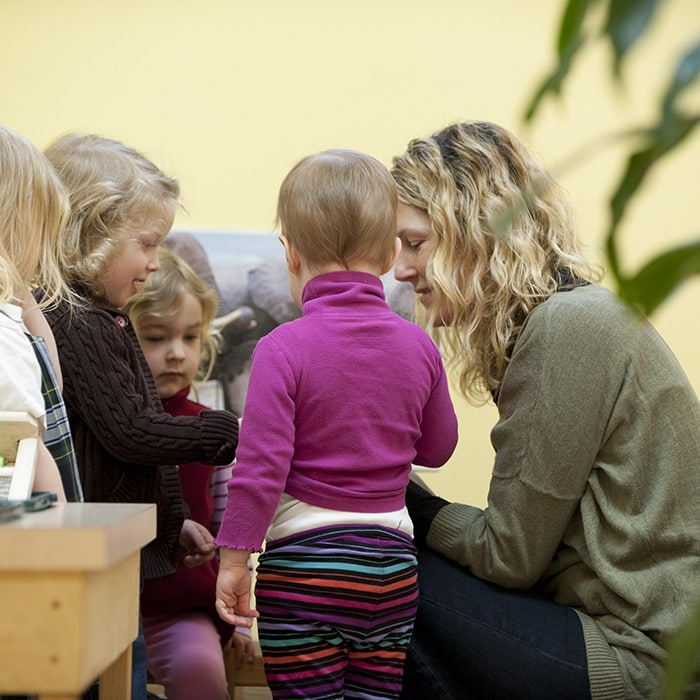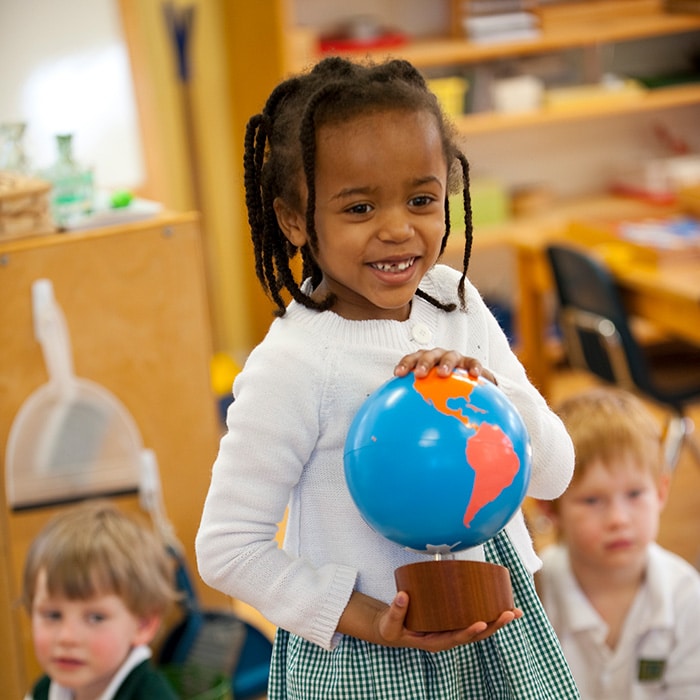Preschool: TODDLER
“She begs me every morning, even on the weekends, to go to school. ”
Karen Kafel, Parent
Preschool: TODDLER
“She begs me every morning, even on the weekends, to go to school. ”
Karen Kafel, Parent
The environment for the Clanmore Montessori preschool child allows for the development of skills through exploration and manipulation of specifically designed materials in a caring and nurturing private school environment.
DEVELOPMENTAL CHARACTERISTICS
This period of development is one of intense psychological growth. In it, children develop the foundation of their personality through experiences with the environment. These children are sensorial explorers and have what Dr. Montessori calls the “Absorbent Mind”. They have a strong sense of order, so predictable routines set in an environment that minimizes change helps the children to achieve a sense of security between themselves, the environment, and the people in it. Routine and knowing what to expect is essential for their future confidence and independence.
Communication with parents is a daily ritual of the Toddler Environment, as it is an extension of the home environment.
SOCIAL DEVELOPMENT
Respect, love, and kindness are modeled by the teachers and the older children in the school. This is known in the Montessori Curriculum as “Grace and Courtesy”. Children are engaged in social life in the environment, and have the freedom to choose the work from the shelves for their inner necessities. In return, this freedom to develop brings internal order. When children are free to follow their inner needs, a deep satisfaction appears, and order comes.
The children are given lessons on the materials and use them for real, practical, meaningful work. Preparation of, and eating, food provide the opportunities to learn the social graces of being in a group. This includes offering, waiting a turn, setting a table, and all the verbal communication that goes along with these daily acts, that make up our toddler community.
PRACTICAL LIFE
The Practical Life activities mimic the home environment, as these serve a purpose and allow children to refine their movements to perfect a skill. These exercises appeal to the child as they give a sense of order and provide opportunity for repetition and mastery. They offer the development of internal order, coordination of movements and self-control.
Food is an important part of the Toddler environment. It provides cohesion as a community while interesting discoveries are made. For example, during snack time, information about fruits and vegetables is learned. Food preparation allows for the exploration of new tastes, textures, and vocabulary.
SENSORIAL
Children at this age use their senses to process information and need to touch, feel, hold and carry anything and everything around them.
The toddler environment is prepared for this purpose. The interests of the child is exposed, and guidance can be given with materials for language and visual discrimination of size, shape and colour. This aids in the child’s discovery and independence, which leads to the organization of thought and deep concentration.

LANGUAGE
Language develops naturally and spontaneously for the children in the toddler environment. It is an unconscious activity that awakens gradually and produces beautiful words. Later it becomes a conscious effort for communication, and an explosion of vast vocabulary. This is the beginning of a new period, the Organization of Language.
Language and speech is connected to everything in the environment. It involves acquisition of vocabulary, pronunciation, the powers of expression, and communication. The classroom is enriched with language using classified objects (dogs, bears, insects, fruits, vegetables, etc.), classified cards, puzzles, games, songs, rhymes, stories (storytelling) and fingerplays. Every new discovery brings an opportunity to learn new vocabulary, enriched vocabulary, and engage in conversations.
MATHEMATICS
This period of development is a time of great sensitivity to external order.
An orderly environment is ideal for a mathematical mind in the making. The child’s need for order is satisfied in the Toddler environment by having distinct places where all objects and materials are kept, and promoting a cycle of activity that includes choosing their work from the shelf, using it, and returning it to its place. This helps with the process of organization while the essence of the work is absorbed. This foundation of organization indirectly helps with abstract thought later in life.
The children are indirectly prepared for mathematics by the classification of objects, colours and shapes, and counting and sorting according to size, shape, and colour.
TECHNOLOGY
At this early and critical period of brain development, the focus is on the child’s need for movement, and the processing of information through all the senses. This is achieved through the use of three-dimensional materials that are capable of presenting real concepts such as texture, taste, relative size and weight.
The use of technology appears in the Upper Elementary curriculum, as the students are introduced to the use of computers as tools to enhance their work.

PURPOSEFUL Activity
- Environments prepared to foster activity supporting natural development
- Self-directed activities allow freedom to make mistakes and learn from them
- Confidence and self-esteem increase each successful step



